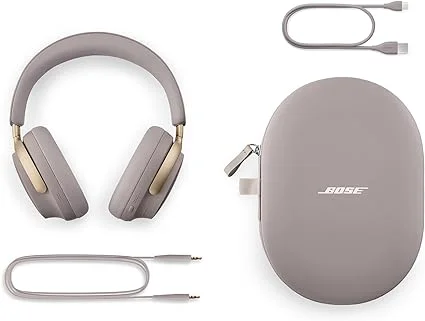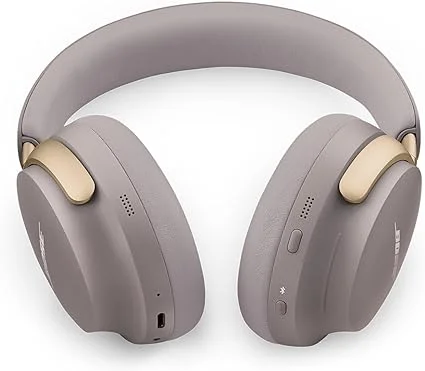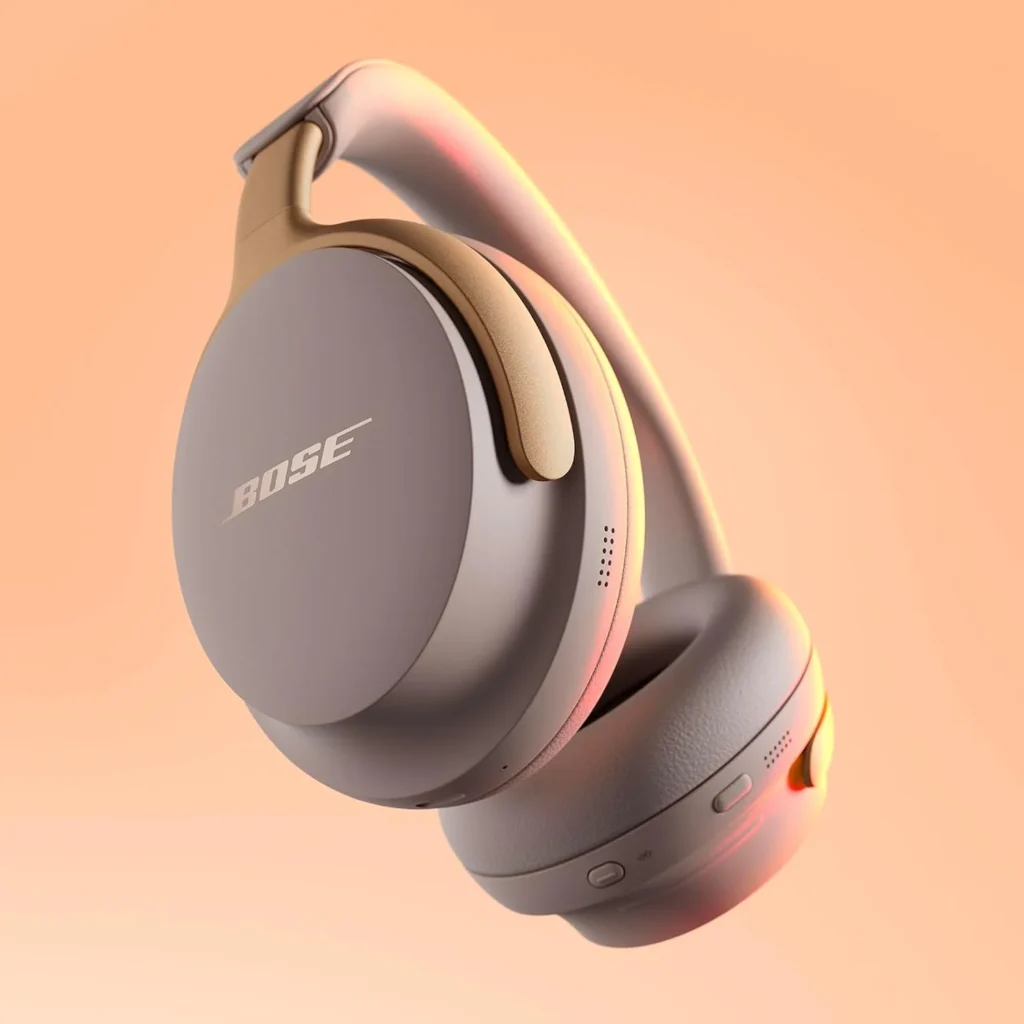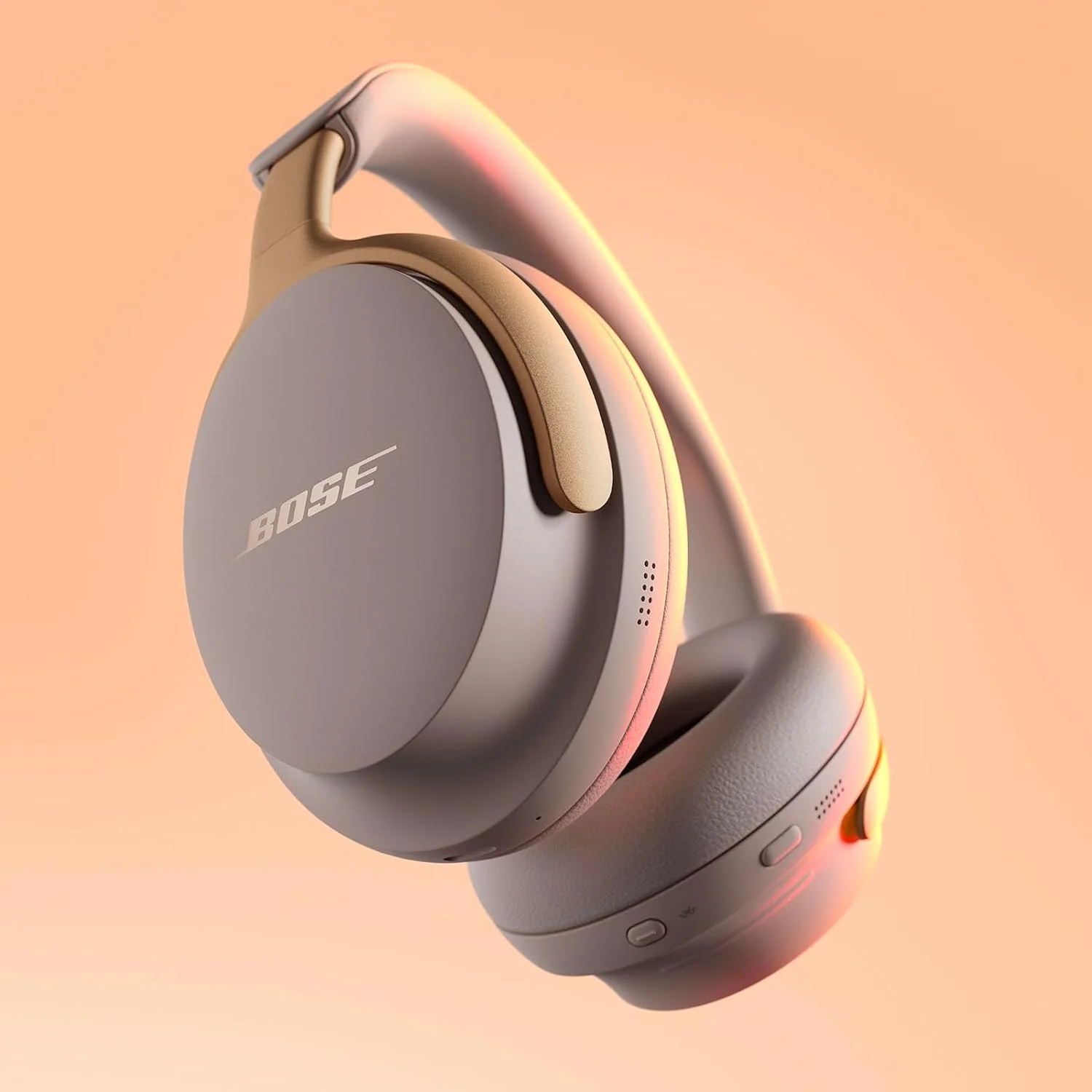Bose QuietComfort review 2024
Bose QuietComfort
| Brand | Bose |
| Model Name | Bose QuietComfort Ultra Wireless Noise Cancelling Headphones with Spatial Audio, Over-the-Ear Headphones with Mic, Up to 24 Hours of Battery Life, Sandstone – Limited Edition ColorBose QuietComfort Ultra Wireless Noise Cancelling Headphones with Spatial Audio, Over-the-Ear Headphones with Mic, Up to 24 Hours of Battery Life, Sandstone – Limited Edition Color |
| Color | Sandstone |
| Form Factor | Over Ear |
| Connectivity Technology | Wireless, Wired |
Table of Contents
Introducing the world of Bose Quiet Headphones, where immersive audio experiences meet unparalleled tranquility. Bose, a pioneering name in audio technology, has long been synonymous with innovation and excellence. With their Quiet series of headphones, Bose has redefined the way we listen to music, watch movies, and engage in conversations, all while prioritizing peace and serenity in our bustling surroundings.
In this introduction, we’ll delve into the captivating world of Bose Quiet Headphones, exploring their cutting-edge features, superior sound quality, and advanced noise-canceling technology that sets them apart in the realm of audio accessories. Whether you’re a music enthusiast, frequent traveler, or professional seeking focus in a noisy environment, Bose Quiet Headphones promise to deliver an unparalleled audio experience tailored to your needs.
Sound Quality
When it comes to high-quality headphones, Bose QuietComfort models have consistently set the standard, especially in the realm of sound quality. For audiophiles and casual listeners alike, understanding the nuances of “Bose quiet sound quality” can help in making an informed purchasing decision. This post dives deep into the various aspects that contribute to the exceptional sound quality of Bose QuietComfort headphones.
Bose QuietComfort headphones are renowned for their superb audio performance. They offer a balanced frequency response that ensures clarity and detail across all sound spectrums—highs, mids, and lows. The bass is rich without being overpowering, the mids are smooth and natural, and the highs are crisp and clear. Compared to competitors, Bose consistently delivers a more refined and natural sound, making their headphones a favorite among discerning listeners.
A key feature of Bose QuietComfort headphones is their advanced noise cancellation technology. This feature significantly enhances sound quality by eliminating external noise, allowing listeners to focus on the pure sound of their music or calls. The noise cancellation performance is stellar in various environments, whether you’re in a noisy office, on public transport, or walking through a busy street. User experiences and expert reviews frequently highlight the effectiveness of this feature, noting that it makes a substantial difference in sound clarity and overall listening experience.
The acoustic design of Bose QuietComfort headphones plays a crucial role in their sound quality. The ear cup design, along with the materials used in construction, contributes to excellent sound isolation and minimal sound leakage. The combination of these factors ensures that the headphones deliver a consistent and immersive audio experience, free from external distractions.
Sound customization options available through the Bose app allow users to tailor their listening experience to their preferences. The app offers various equalizer settings and presets that let users adjust the sound profile to suit different genres of music. This level of control over sound settings is a significant advantage for those who like to tweak their audio to perfection.
Driver technology is another important aspect of sound quality. Bose QuietComfort headphones use high-quality drivers that are engineered to deliver precise and accurate sound reproduction. The type and size of these drivers contribute to the headphones’ ability to produce a wide dynamic range and detailed audio, ensuring that every note and nuance is faithfully reproduced.
.

Noise Cancellation
Noise cancellation technology has revolutionized the way we experience sound, especially in the realm of headphones and other audio devices. In this post, we’ll explore the intricacies of noise cancellation, its effectiveness, and how it enhances our auditory experiences.
Noise cancellation can be broadly categorized into three types: Active Noise Cancellation (ANC), Passive Noise Cancellation (PNC), and Hybrid Noise Cancellation. Active noise cancellation works by using microphones to pick up external sounds and then generating sound waves that are the exact opposite (or “anti-noise”), effectively canceling out the unwanted noise. Passive noise cancellation, on the other hand, relies on physical barriers such as ear cups or ear tips to block out external noise. Hybrid noise cancellation combines elements of both active and passive methods to achieve optimal noise reduction.
The effectiveness of noise cancellation varies depending on the type of noise and the environment. In general, noise-canceling headphones excel at blocking out low-frequency sounds, such as the rumble of airplane engines or the hum of air conditioners. They are also effective at reducing mid-frequency sounds, such as the chatter of coworkers in an office setting. However, they may struggle to block out high-frequency sounds, such as the shrill noise of a siren or the screech of brakes.
When it comes to performance in different environments, noise-canceling devices shine in situations where there is a constant background noise. Whether you’re working in a bustling office, commuting on a noisy train, or trying to relax in a crowded cafe, noise cancellation can significantly improve your listening experience by reducing distractions and allowing you to focus on the task at hand.
One factor to consider when choosing a noise-canceling device is its impact on battery life. Since active noise cancellation requires additional power, noise-canceling headphones typically have shorter battery life compared to non-noise-canceling models. However, advancements in battery technology have led to improvements in this area, with many devices now offering several hours of use on a single charge.
Comfort and Design
In today’s fast-paced world, where comfort and design are paramount, consumers are increasingly seeking products that not only look good but also feel good. From furniture to clothing to technology, the intersection of comfort and design plays a crucial role in shaping our everyday experiences.
Consider, for example, the evolution of ergonomic office chairs. Gone are the days of stiff, uncomfortable seating arrangements. Today’s office chairs are designed with the human body in mind, featuring adjustable lumbar support, breathable mesh backing, and contoured seat cushions to ensure optimal comfort during long hours at the desk.

Similarly, advancements in clothing design have led to the creation of garments that are as comfortable as they are stylish. From moisture-wicking fabrics in activewear to stretch denim in jeans, clothing manufacturers are prioritizing comfort without sacrificing fashion. The result? Clothing that moves with you, whether you’re working out at the gym or lounging at home.
In the realm of technology, comfort and design go hand in hand in products such as headphones and smartphones. Over-ear headphones with plush ear cushions and adjustable headbands provide a comfortable listening experience, while sleek, modern designs add a touch of sophistication. Smartphones with slim profiles and curved edges fit comfortably in the hand, making them a pleasure to use for extended periods.
But comfort and design aren’t just about physical attributes; they’re also about creating environments that promote well-being and productivity. Interior designers and architects are increasingly incorporating elements such as natural light, ergonomic furniture, and biophilic design principles to create spaces that are not only aesthetically pleasing but also conducive to comfort and relaxation.
Battery Life
In the realm of electronics, one factor reigns supreme: battery life. From smartphones to laptops to wearable devices, the longevity of a device’s battery can make or break its usability and user satisfaction. In this post, we delve into the intricacies of battery life, exploring its importance, factors influencing it, and tips for optimizing it.
Battery technology forms the backbone of modern electronics, powering our devices and enabling us to stay connected and productive on the go. Understanding the different types of batteries used in electronic devices—such as lithium-ion and nickel-metal hydride—can provide insights into their performance and longevity.
Several factors affect battery life, including usage patterns, operating system optimization, hardware components, and environmental conditions. How often you use your device, what apps you run, and even the temperature of your surroundings can all impact how long your battery lasts between charges.
Battery capacity, measured in milliampere-hours (mAh), is a key determinant of battery life. Devices with higher battery capacities generally offer longer runtimes, allowing users to go longer between charges. Screen-on time is another crucial metric, indicating how long a device’s screen can stay lit before needing to be recharged.
Charging speed and efficiency play a significant role in user convenience and device usage. Fast charging technologies, such as Qualcomm Quick Charge and USB Power Delivery, have revolutionized the way we recharge our devices, reducing downtime and ensuring we stay powered up when we need it most.
Standby time, or the amount of time a device can remain idle on a single charge, is also an important consideration for battery life. Background processes, connectivity options, and other factors can drain a device’s battery even when it’s not in active use, so optimizing standby time is crucial for maximizing battery longevity.
Fortunately, there are plenty of battery optimization tips and tricks that users can employ to extend their device’s battery life. Adjusting settings, disabling unnecessary features, and using battery-saving apps are just a few examples of how users can squeeze more juice out of their devices between charges.
When comparing battery life across different devices, it’s essential to consider real-world usage scenarios. Battery life can vary significantly depending on factors such as device type, usage patterns, and hardware specifications, so relying solely on manufacturer-reported figures may not provide an accurate picture of performance.
Connectivity
In today’s interconnected world, the importance of connectivity cannot be overstated. From smartphones to smart homes, virtually every aspect of our lives relies on the ability to connect to the internet, other devices, and the world around us. In this post, we’ll explore the intricacies of connectivity, from wireless to wired, and how it impacts our daily experiences.
Wireless connectivity has become ubiquitous in our lives, enabling us to stay connected no matter where we are. Technologies like Wi-Fi, Bluetooth, and NFC allow us to wirelessly transfer data, stream media, and control smart devices with ease. These wireless connections offer convenience and flexibility, freeing us from the constraints of cables and cords.
But wired connectivity still has its place, offering reliable and high-speed connections for tasks that demand stability and performance. USB, Ethernet, and HDMI connections remain essential for connecting devices like computers, gaming consoles, and home entertainment systems. While wireless technologies have made great strides, wired connections continue to offer unparalleled speed and reliability in many scenarios.
Internet connectivity is perhaps the most crucial aspect of connectivity in today’s digital age. Whether it’s through Wi-Fi, cellular data, or wired Ethernet connections, access to the internet is essential for accessing online services, streaming content, and staying connected with others. The quality of our internet connection can greatly impact our productivity, entertainment, and overall user experience.

Controls and Features
In the realm of product design, controls and features play a pivotal role in shaping user experiences and functionalities. Whether it’s the tactile buttons on a remote control or the intuitive interface of a smartphone, the design and implementation of controls and features can greatly influence how we interact with and utilize a product. In this post, we’ll delve into the intricacies of controls and features, exploring their importance, variations, and impact on user satisfaction.
User interface (UI) is a fundamental aspect of controls and features, encompassing how users interact with a product. From physical buttons to touchscreen displays, the UI serves as the gateway through which users navigate menus, settings, and functionalities. The design of the UI, including its layout, responsiveness, and customization options, can significantly enhance or hinder the user experience.
Physical controls, such as buttons, knobs, and touchpads, provide tactile feedback and direct interaction with a product. The placement and design of physical controls affect ease of use, ergonomics, and accessibility, catering to diverse user preferences and needs. Similarly, touchscreen interfaces offer intuitive navigation and interactive experiences, allowing users to interact directly with digital content through gestures and taps.
Voice control has emerged as a prominent feature in many products, enabling hands-free operation and voice-activated commands. Integration with virtual assistants like Siri, Google Assistant, and Alexa enhances convenience and accessibility, allowing users to perform tasks and access information using natural language commands.
Gesture control represents another innovative approach to user interaction, leveraging motion sensors and cameras to detect and interpret gestures. This hands-free method of control offers a futuristic and immersive user experience, particularly in applications like gaming, virtual reality, and smart home automation.
Remote controls remain a staple in home entertainment systems, offering convenient access to TV channels, streaming services, and connected devices. The design and functionality of remote controls, including button layout, range, and programmability, can greatly impact user convenience and satisfaction.
Portability
In a world where mobility is key, the concept of portability has become increasingly important across various products. From electronics to outdoor gear to household appliances, the ability to easily carry or transport items has become a crucial factor for consumers. In this post, we’ll explore the nuances of portability, examining different aspects and considerations that influence the portability of products.
One of the primary considerations when assessing portability is the size and dimensions of the product. Compactness and slim profiles are often desirable traits, allowing products to fit into tight spaces or be easily carried in bags or pockets. Conversely, larger or bulkier items may be more cumbersome to transport, limiting their practicality for on-the-go use.
Weight is another key factor in determining portability. Lighter-weight products are generally easier to carry and transport, especially over longer distances or extended periods. Heavy items may require more effort to move around, potentially impacting user convenience and comfort.
Foldability or collapsibility can significantly enhance the portability of certain products, allowing them to be easily stored or transported when not in use. Products that can fold down into smaller sizes or collapse for storage take up less space and are more convenient to transport, making them ideal for travel or storage in small spaces.
Portability features such as carrying handles, straps, or wheels can further enhance the ease of transport for certain products. These features provide additional convenience and functionality, allowing users to easily carry or roll products from one location to another without strain or discomfort.
Battery life and power source are important considerations for portable electronics and devices. Longer battery life or alternative power source options (such as rechargeable batteries or solar power) can extend the usability of portable products, allowing users to stay connected or powered up even when away from traditional power sources.
Durability and build quality are crucial for products intended for use in various environments or conditions. Portable items need to withstand the rigors of travel, outdoor use, or frequent handling without succumbing to damage or wear and tear. High-quality materials and construction methods contribute to the overall durability and longevity of portable products.
Build Quality and Durability
In the realm of consumer products, few attributes are as crucial as build quality and durability. These two factors can significantly impact the lifespan, performance, and overall satisfaction with a product. In this post, we delve into the intricacies of build quality and durability, exploring what they entail and why they matter.
At the heart of build quality lies the choice of materials used in the construction of a product. Whether it’s sturdy metals, robust plastics, or premium glass, the materials used can determine a product’s resilience and longevity. Products crafted from high-quality materials tend to withstand the test of time, maintaining their structural integrity even under challenging conditions.
Equally important is the method of construction employed during manufacturing. Molding, machining, and assembly techniques can all influence a product’s durability and reliability. Well-executed construction methods result in products that are solidly built and less prone to defects or failures.
Strength and sturdiness are key indicators of a product’s build quality. A well-built product should feel solid and substantial in hand, capable of withstanding everyday wear and tear without succumbing to damage. Products that exhibit strength and sturdiness instill confidence in users, assuring them of their reliability and durability.
Resistance to wear and tear is another hallmark of superior build quality. Products that resist scratches, scuffs, and surface damage maintain their appearance and functionality over time. This resistance to wear ensures that the product remains aesthetically pleasing and performs optimally throughout its lifespan.
In addition to wear and tear, products may also need to withstand exposure to water, moisture, and weather elements. Waterproof, water-resistant, and weatherproof features enhance a product’s durability, allowing it to be used safely in outdoor or adverse conditions without fear of damage or deterioration.
Impact resistance is crucial for products that are susceptible to drops, bumps, or accidents. A well-built product should be able to withstand occasional impacts without sustaining damage or compromising its functionality. Impact-resistant features protect the product and ensure its continued usability even after minor mishaps.
Scratch and abrasion resistance further contribute to a product’s longevity and durability. Products that resist scratches and abrasions maintain their appearance and integrity, preserving their aesthetic appeal and functional performance over time.
Corrosion resistance is essential for products that may be exposed to corrosive substances or environments. Rust and corrosion can weaken materials and compromise a product’s structural integrity. Products that are corrosion-resistant remain robust and reliable even in harsh or corrosive conditions.

Microphone Quality
In today’s audio-centric world, microphone quality stands as a pivotal aspect, influencing the clarity and fidelity of recorded sound. Whether it’s capturing vocals for a podcast, recording music in a studio, or conducting video conferences, the quality of the microphone can significantly impact the overall experience. In this post, we delve into the intricacies of microphone quality, exploring its various dimensions and how it affects different applications.
Types of Microphones:
Microphones come in various types, each with its unique characteristics. Condenser microphones are renowned for their sensitivity and ability to capture intricate details, making them popular for studio recordings and professional applications. Dynamic microphones, on the other hand, are more rugged and versatile, often favored for live performances and outdoor use. Ribbon microphones offer a vintage sound and smooth response, ideal for capturing acoustic instruments and vocals with warmth and character.
Frequency Response:
Frequency response refers to a microphone’s ability to capture different frequencies accurately. A wider frequency response range allows the microphone to reproduce a broader spectrum of sounds, from deep lows to crisp highs. When assessing microphone quality, it’s essential to consider the frequency response curve and how it influences the tonal balance and sonic characteristics of the recorded audio.
Directionality:
Microphone directionality determines its sensitivity to sounds from different directions. Cardioid microphones are the most common, focusing on capturing sound from the front while rejecting noise from the sides and rear. Omnidirectional microphones capture sound equally from all directions, making them suitable for capturing ambient sounds or group recordings. Bidirectional microphones pick up sound from the front and back while rejecting noise from the sides, making them ideal for interviews and duets.
Sensitivity:
Microphone sensitivity refers to its ability to capture soft or distant sounds. A microphone with high sensitivity can pick up subtle nuances in the audio, making it ideal for capturing delicate instruments or vocals. However, high sensitivity can also lead to increased background noise, requiring careful consideration of the recording environment and microphone placement.
Signal-to-Noise Ratio (SNR):
The signal-to-noise ratio (SNR) measures the level of desired signal (sound) compared to the level of background noise. A high SNR indicates a cleaner and more accurate signal, resulting in better audio quality. When evaluating microphone quality, it’s crucial to consider the SNR rating and how it impacts the clarity and fidelity of recorded audio, especially in quiet or sensitive recording environments.

Pros and Cons Summary
Pros:
- Comprehensive Comparison: A pros and cons summary provides a comprehensive overview of different products or topics, allowing readers to quickly understand their key features and benefits.
- Informed Decision-Making: By listing the pros and cons of each option, readers can make more informed decisions based on their preferences and priorities.
- Efficiency: Pros and cons summaries save time for readers by presenting the most important information in a concise and easy-to-understand format.
- Transparency: Highlighting both the strengths and weaknesses of each option promotes transparency and helps readers evaluate products or topics objectively.
- Clarity: Organizing information into pros and cons makes it easier for readers to compare and contrast different options, leading to clearer insights and conclusions.
Cons:
- Subjectivity: Pros and cons summaries may reflect the biases or opinions of the author, leading to potential discrepancies in the evaluation of products or topics.
- Limited Scope: Due to space constraints, pros and cons summaries may not cover every aspect or detail of each option, potentially overlooking important considerations.
- Lack of Context: Without additional context or explanation, readers may struggle to fully understand the significance of each listed pro or con, leading to misinterpretation.
- Simplification: Summarizing complex information into pros and cons may oversimplify nuanced topics, potentially missing subtleties or complexities.
- Overreliance: Relying solely on pros and cons summaries may overlook other valuable sources of information, such as detailed reviews or expert opinions.
Conclusion
In conclusion, comparison tables are invaluable tools that simplify the decision-making process for consumers faced with a myriad of product options. By distilling complex information into clear and concise formats, these tables empower users to make well-informed choices tailored to their specific needs and preferences.
Throughout this discussion, we’ve highlighted the key components of comparison tables and their role in aiding consumers:
- Product Features: Offering an overview of key specifications and features.
- Performance Metrics: Providing insights into speed, accuracy, and power consumption.
- Price and Affordability: Helping users identify the most cost-effective option.
- Compatibility and Connectivity: Ensuring seamless integration with other devices or systems.
- Durability and Build Quality: Assuring users of reliability and longevity.
- User Interface and Ease of Use: Enhancing the overall user experience.
- Battery Life and Power Source: Crucial for portable devices, ensuring sustained usage.
- Portability and Size: Important for users on the move, offering convenience.
- Customer Reviews and Ratings: Offering real-world perspectives and feedback.
- Warranty and Support: Providing reassurance and assistance post-purchase.
By considering these factors, consumers can navigate the vast array of product choices with confidence, ultimately selecting products that best meet their needs and expectations.
